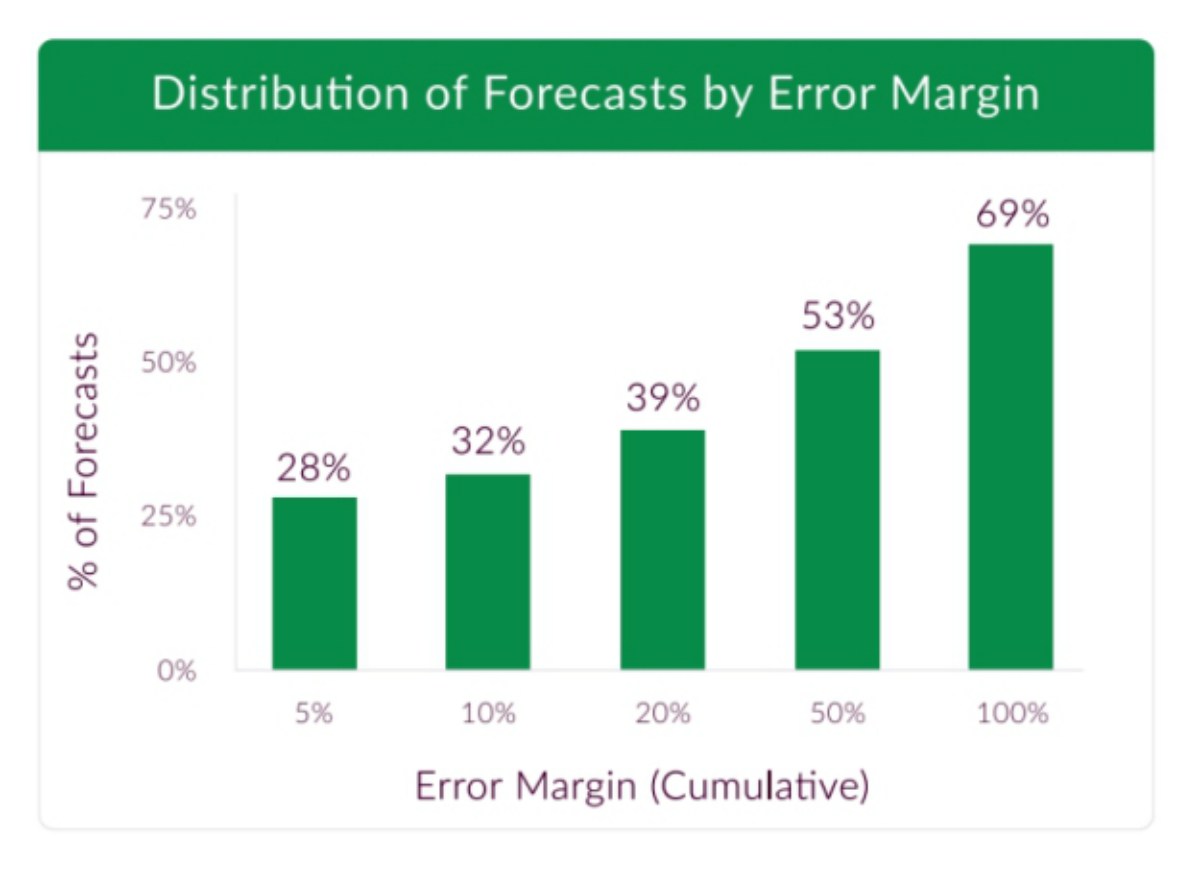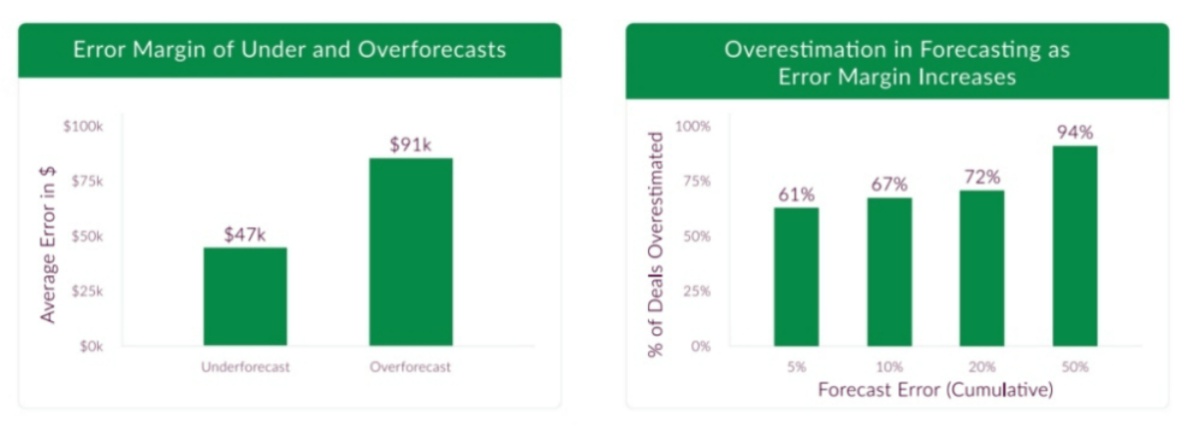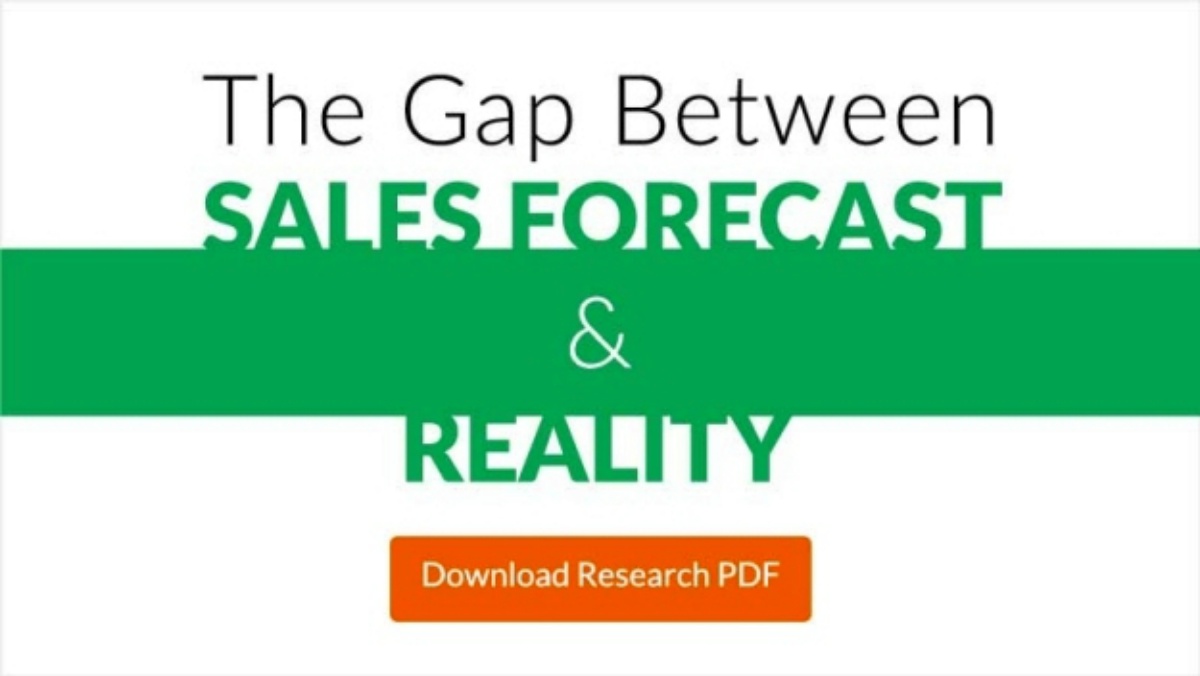Only 28% Of Business Deals Are Forecasted Accurately, Shows New Research
Xant Team
Did you know that less than 30% of deals are forecasted accurately? Keep reading to learn more about why this the case and how you can potentially improve the figures for your team in this article.
RELATED: 5 Strategies For More Accurate Sales Forecasting
In this article:
- The Issue With Sales Forecasting
- Forecast Accuracy Versus Reality in the Sales Forecasting Process
- Accurate Sales Forecasts? | Only 28.1% of Forecasts Are Close to Being Accurate
- Sales Reps Overestimate by Nearly 2x as Much as They Underestimate
- Importance of Accurate Forecasting in Sales
- Reasons Why Sales Forecasts Are Often Inaccurate
- Increasing Sales Forecasting Accuracy With AI or Sales Forecast Software
- Conclusion
The Gap Between Forecasting and Reality | Inaccurate Forecasted Deals
The Issue With Sales Forecasting
Many sales leaders are frustrated about the hit-and-miss aspect of sales forecasting. With mountains of data cramped into sales forecast spreadsheets and no meaningful way to find out what’s really important, it sometimes feels like nothing more than reading the tea leaves.
New data from XANT shows it’s not far from the truth. Only 28.1% of closed deals are predicted accurately 90 days out, and the actual close amounts differ by 31% from forecasts, showed by new research on sales forecasting by XANT Labs.
Sales Forecasting Definition: This is the process of predicting how future sales activities will result. Sales forecasting helps organizations make better business decisions like managing manpower, prioritizing sales activities, and so on.
Forecast Accuracy Versus Reality in the Sales Forecasting Process

In our latest study, “The Gap Between Forecasting and Reality,” we analyzed 270,912 closed won opportunities making up over $18.1 billion in closed sales revenue from 18 companies. It was an eye-opening exercise of sales forecasting statistics.
The results showed there’s an immense gap between what sales leaders forecast and what happens at the end of the quarter.
We knew that in 2016, CSO Insights data showed only 45.8% of forecasted deals closed as predicted.
That’s less accurate than flipping a coin.
However, our numbers have shown the disconnect is even more dramatic. There’s a massive gap between what sellers ‘think’ they do and what they actually do.
Accurate Sales Forecasts? | Only 28.1% of Forecasts Are Close to Being Accurate

Shockingly, only 28.1% of the opportunities we analyzed closed within 5% of the 90-day forecasted amount.
This is significantly different than the CSO Insights number from 2016, which may be explained by the source of the relevant data. Specifically, CSO Insights gathered data through surveys, while ZANT used software to track specific dollar amounts.
Looking deeper, we found that 47% of 90-day predictions were off by a margin of more than half!
Across all of our data, the average 90-day prediction for closed-won opportunities missed the mark by over 31%.
Sales Reps Overestimate by Nearly 2x as Much as They Underestimate
If you have a gut feeling your sales pipeline is inflated, you’re probably right.
Sales reps are notoriously optimistic, and the truth is — you have to be, to be able to work in this business. However, the sales rep’s poor forecasting skills often allow deals that will never close to linger in the pipeline.
The data shows that when rep’s forecasts were off, they overestimated by an average $91,000 and underestimated by only $47,000.
With that said, the average size of all forecasts in our sample was under $81,000. This means that reps are more likely to be overly optimistic about large deals.
Our analysis also showed that the more important the deal, the more likely you are to overestimate its outcome.
RELATED: Building A Sales Forecasting Strategy That Works
Importance of Accurate Forecasting in Sales
This research is essential for any salesperson, particularly sales leaders, since it shows the importance of accurate forecasting in sales. If what you forecasted is wrong, it can affect a lot of sales processes and the results that come with it.
Sales forecasts are essential in an organization in many ways:
- Sales forecasts help a company in budgeting. By getting an idea of future demand for their product or service, teams can plan their supply.
- It can also help in planning future organization activities. Whether there’s a dip or a spike in demand, people will know which activities they have to prioritize.
- Another reason why forecasting in sales is essential is that it helps in goal-setting. Reporting sales forecasts help set goals that are challenging but still realistic and achievable.
These are some of the reasons why accuracy in sales forecasts is crucial.
A lot of business decisions are made based on what predictions are reported. Thus, if they tend to be more inaccurate than accurate, a lot of variables and factors will be affected.
Reasons Why Sales Forecasts Are Often Inaccurate
Why are a lot of sales forecasts inaccurate in the first place? Why are the projected results not being met? Here are some potential reasons:
1. You’re Not Using High-Quality Data
Even if you’re using your customer relationship management (CRM) software as a source of forecasting data, it doesn’t guarantee you’re getting accurate information. Chances are, people are slacking when it comes to keeping this updated.
Thus, make sure you communicate the importance of inputting accurate and updated information in the CRM.
2. You Don’t Have a Strong Basis for Sales Predictions
Historical data is an excellent way of making sure your forecasts are accurate. However, not a lot of people use it when sales forecasting.
Instead, they rely on their gut feeling. Gut feeling is not a reliable and robust basis for any sort of prediction — it’s not even measurable.
How can you be sure you can reach specific benchmarks if you haven’t checked how you’ve done so far?
3. Your Sales Forecasting Technique Is Outdated or Needs Some Work
Sometimes, it’s how you forecast that may not be working out for you.
You may have the correct data, and even might be managing expectations right.
However, none of that matters if your forecasting tool isn’t the right one. At the end of the day, it won’t give you accurate results.
It’s time to look into whether or not you need to update your forecasting techniques. Perhaps you need an upgrade to increase your sales forecasting accuracy.
Increasing Sales Forecasting Accuracy With AI or Sales Forecast Software
Sales forecasting doesn’t have to be like looking through a crystal ball.
Technology has advanced significantly, and it can help with revenue projections. We now have the tools to enhance human judgment with predictive insights for more accurate results.
Artificial Intelligence (AI) can analyze past sales interactions and outcomes to understand the critical characteristics of good and bad deals, helping you clean up the pipeline. AI sales technology can improve forecasting accuracy by up to 30%.
A sales forecasting software powered by AI is created for this specific task.
It can also help improve the sales team performance by highlighting the sales activities that actually lead to closing business. Once you pinpoint what makes a good deal and a great sales rep, managers can easily coach the sales reps for success.
A simple improvement in daily activities for just 20% of the sales team can lead to millions in revenue.
Conclusion
A leaders’ ability to accurately project quarterly revenue is crucial to business growth plans. The problem is that even when sales leaders correctly call which deals will close, the size of each opportunity varies.
It varies so widely as to make it nearly impossible to make an accurate sales forecast.
A pipeline management and sales forecasting tool that uses AI to help you close more of the right deals and accurately forecast revenue is an excellent help. It can offer businesses the confidence they need for their financial projections.

What do you think of our research in the sales forecast? Have you also noticed a trend of inaccuracies in forecasted deals? Share your thoughts or questions in the comments section below.
Up Next:
- XANT Debuts Next Generation AI Sales Platform
- Next Gen Sales Technology Powered By Collective Intelligence W/ Dave Boyce @ZANT
Editor’s Note: This post was originally published on July 30, 2018, and has been updated for quality and relevancy.